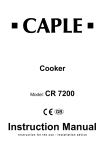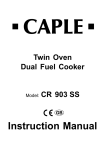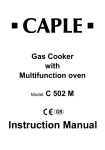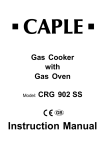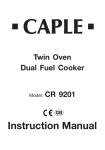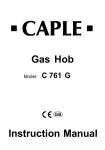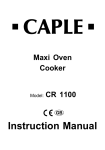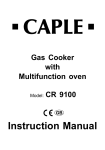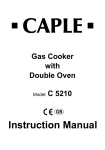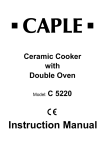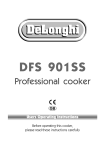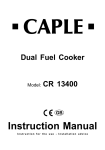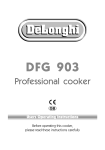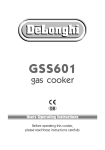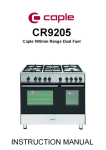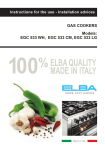Download Caple CR 9210 Instruction manual
Transcript
Twin Oven Gas Cooker Model: CR 9210 GB Instruction Manual Thank you for buying your new CAPLE cooker. To ensure that you get the best results from your new CAPLE cooker, we strongly suggest that you read this instruction manual thoroughly before use. This manual contains installation advice, cleaning tips and a cooking guide, as well as other important facts about your CAPLE cooker. If treated with care, your CAPLE appliance should give you years of trouble-free cooking. For Spare Parts, Technical Advice or Product Service call the CAPLE HELPLINE on 0870 241 1142 (Answerphone outside office hours) Important: This appliance is designed and manufactured solely for the cooking of domestic (household) food and is not suitable for any non domestic application and therefore should not be used in a commercial environment. This appliance guarantee will be void if the appliance is used within a non domestic environment i.e. a semi commercial, commercial or communal environment. The - 2 CE marking confirms that the appliance conforms to the following EU directives: safety requirements of EEC Directive “Gas” 90/396; safety requirements of EEC Directive “Low voltage” 73/23; protection requirements of EEC Directive “EMC” 89/336; requirements of EEC Directive 93/68. Safety Reminders Instruction Book This appliance should only be used for it’s intended purpose as described in these instructions. Ensure that you fully understand these instructions before operating this appliance. DO NOT line the oven, grids, trays etc. with aluminium foil as this could adversely affect the heating elements and it could also damage the interior surfaces. Do not place baking trays or the drip tray on the base of the oven chamber. DO NOT place flammable materials in the Space Requirements Ensure that the specified ventilation space around the appliance is not obstructed. Food Splashes Always wipe clean the oven after use. Food splashes can carry on cooking next time and may become a fire hazard. Hot Surfaces It is important to remember that the surfaces of cooking appliances get hot during use and retain the heat for some time after switching off. It is therefore advisable to keep small children away from the appliance. The Grill Burner is exposed, so take great care when placing food in the oven or removing it. Use the grill pan handles or gloves. oven or in the storage compartment Faults Do not continue to use this appliance if it appears to be faulty. After Use After use, ensure that the hob knobs are in position ● (off), and close the main gas delivery valve or the gas cylinder valve. Always switch off at the isolating switch before cleaning the appliance, or attempting any maintenance task, or when not in use for long periods (when on holiday). CAPLE Service To ensure the continued safe and efficient operation of this appliance, we recommend that any servicing or repairs are carried out only by an authorised CAPLE SERVICE ENGINEER. Before Use Check that all accessories have been removed from the oven interior. Set the temperature to the maximum position ( ) using the temperature control knob. Leave on for approximately 30 minutes. This will burn off any protective coating applied to the oven during manufacture. The kitchen should be well ventilated during this time as there may be an odour given off. When cool, wash the accessories and the oven with warm water and mild detergent. 3 1 - Electrical Installation For your safety please read the following information: This appliance must be installed by a qualified technician according with the current local regulations and in compliance with the manufacturer instructions. This appliance has to be equipped with a 13 amp three pin mains plug with a 3 amp fuse fitted. Should the fuse require replacement, it must be replaced with a fuse rated at 3 amp and approved by ASTA or BSI to BS 1362. The plug contains a removable fuse cover that must be refitted when the fuse is replaced. In the event of the fuse cover being lost or damaged, the plug must not be used until a replacement cover has been obtained. Replacement fuse covers can be purchased from your nearest electrical dealer and must be the sarne colour as the original. IF THE MAINS PLUG IS UNSUITABLE FOR THE SOCKET OUTLET IN YOUR HOME OR IS REMOVED FOR ANY OTHER REASON, THEN THE FUSE SHOULD BE REMOVED AND THE CUT OFF PLUG DISPOSED OF SAFELY TO PREVENT THE HAZARD OF ELECTRIC SHOCK. THERE IS A DANGER OF ELECTRICAL SHOCK IF THE CUT OFF PLUG IS INSERTED INTO ANY 13 AMP SOCKET OUTLET. If a replacement plug is to be fitted, please observe the wiring code shown below. Warning! This appliance must be earthed 3 amp fuse Green & Yellow Earth The wire which is coloured GREEN & YELLOW must be connected to the terminal in the plug which is marked with letter "E" or by the Earth symbol or coloured GREEN & YELLOW. Blue Neutral Brown Live Fig. 1.1 4 A properly earthed three pin plug (fused at 3 amps, to BS 1362 ASTA approved) must be used. As the colours of the wires in the mains lead of this appliance may not correspond with the coloured markings identifying the terminals in your plug, proceed as follows. The wire which is coloured BLUE must be connected to the terminal which is marked with the letter "N" or coloured BLACK. The wire which is coloured BROWN must be connected to the terminal which is marked with the letter "L" or coloured RED. Warning! Before effecting any intervention on the electrical parts the appliance must be disconnected from the network. Replacement of the electrical feeder cable To connect the feeder cable to the cooker it is necessary to: – Remove the screw that hold shield “A” behind the cooker (fig. 1.2). – Insert the feeder cable of the suitable section (as described in the next chapter) into the cable clamp “D”. – Connect the phase and earth cables to the terminal block “B” according to the diagram in figure 1.3. – Pull the feeder cable and block it with cable clamp “D”. – Re-mount shield “A”. ; ; ; ; ; ; ; ;;; ;;; FEEDER CABLE SECTION type H05RR-F 230 V PE D 3 x 0,75 mm2 B A Fig. 1.2 230 V L1 N PE (L2) Fig. 1.3 5 FOR THE INSTALLER 2 - Location The cooker must be installed by a qualified technician and in compliance with local safety standards. 450 mm 650 mm This cookers has class “2/1” overheating protection so that it can be installed next to a cabinet. If the cooker is installed adjacent to furniture which is higher than the gas hob cooktop, a gap of at least 200 mm must be left between the side of the cooker and the furniture. The furniture walls adjacent to the cooker must be made of material resistant to heat. The veneered syntetical material and the glue used must be resistant to a temperature of 90°C in order to avoid ungluing or deformations. The cooker may be located in a kitchen, a kitchen/diner or bed-sitting room but not in a room containing a bath or shower. Curtains must not be fitted immediatly behind appliance or within 500 mm of the sides. It is essential that the cooker is positioned as stated below. If the cooker is located on a pedestal it is necessary to provide safety measures to prevent falling out. 200 mm 500 mm t ven air 6 Fig. 2.1 Backguard Before installing the cooker, assemble the backguard “C” (fig. 2.2). 1. 2. 3. 4. The backguard “C” can be found packed at the rear of the cooker. Before assembling remove any protective film/adhesive tape. Remove the two spacers “A” and the screw “B” from the rear of the cooktop. Assemble the backguard as shown in figure 2.2 and fix it by screwing the central screw “B” and the spacers “A”. C B A Fig. 2.2 Fitting the adjustable feet The adjustable feet must be fitted to the base of the cooker before use. Rest the rear of the cooker an a piece of the polystyrene packaging exposing the base for the fitting of the feet. Fit the 4 legs by screwing them tight into the support base as shown in picture 2.4. Fig. 2.3 Fig. 2.4 7 WARNING When raising cooker to upright position always ensure two people carry out this manoeuvre to prevent damage to the adjustable feet (fig. 2.5). WARNING Be carefull: do not lift the cooker by the door handle when raising to the upright position (fig. 2.6). WARNING When moving cooker to its final position DO NOT DRAG (fig. 2.7). Lift feet clear of floor (fig. 2.5). Fig. 2.5 Levellig the cooker The cooker may be levelled by screwing the lower ends of the feet IN or OUT (fig. 2.8). Fig. 2.6 8 Fig. 2.7 Fig. 2.8 Provison for ventilation The room containing the cooker should have an air supply in accordance with BS.5540: Part 2: 1989. All rooms require an openable window or equivalent while some rooms require a permanent vent in addition to the openable window. The cooker should not be installed in a bed-sitting room, of volume less than 21 m3. Where a DOMESTIC COOKER is installed in a room or internal space, that room or internal space shall be provided with a permanent opening which communicates directly with outside air and is sized in accordance with table below. In domestic premises the permanent opening shall be an air vent. If there are other fuel burning appliances in the same room, BS.5540: Part 2: 1989 should be consulted to determine the requisite air vent requirements. If the cooker is installed in a cellar or basement, it is advisable to provide an air vent of effective area 100 cm2, irrespective of the room volume. MINIMUM PERMANENT OPENING FREE AREA FOR FLUELESS APPLIANCE Type of appliance Maximum appliance rated input limit Room volume < 5 m3 Domestic oven, hotplate, grill or any combination thereof. None 100 cm2 5 m3 to 11 m3 to > 20 m3 10 m3 20 m3 50 (❊) cm2 Nil cm2 Nil cm2 Openable window or equivalent also required Yes (❊) If the room or internal space containing these appliances has a door which opens directly to outside, no permanent opening is required. 9 3 - Gas connection Gas installation Gas connection Important note The installation of the cooker to Natural Gas or LP Gas must be carried out by a qualified gas engineer. Installers shall take due account of the provisions of the relevant British Standards Code of Practice, the Gas Safety Regulations and the Building Standards (Scotland) (Consolidation) Regulations issued by the Scottish Development Department. This appliance is supplied for use on NATURAL GAS only and cannot be used on any other gas without modification. This appliance is manufactured for conversion to LPG if required and is supplied with a conversion kit. The cooker must be installed by a qualified person in accordance with the Gas Safety (Installation and Use) (Amendment) Regulation 1990 and the relevant building/l.E.E. Regulations. The following British Standards should be used as reference when installing this appliance. BS6172 1990, BS5440 part 2 1989 and BS6891 1988. Failure to install the appliance correctly could invalidate any manufacturers warranty and lead to prosecution under the above quoted regulation. In the UK C.O.R.G.I registered installers are authorised to undertake the installation and service work in compliance with the above regulations. Installation to Natural Gas Installation to Natural Gas must conform to the Code of Practice, etc. The supply pressure for Natural Gas is 20 mbar. Installation to LP Gas This appliance must only be connected to LPG after an LPG conversion kit has been fitted, (see pages from 12 to 18). When operating on Butane gas a supply pressure of 28-30 mbar is required. When using Propane gas a supply pressure of 37 mbar is required. The installation must conform to the relevant British Standards. Warning: Only a qualified gas engineer, also with technical knowledge of electricity should install the cooker. He should observe the Regulations and Codes of Practice governing such installation of gas cookers. Note: It is recommended that the gas connection to the cooker is installed with a flexible connecting tube made to BS 5386. 10 Gas connection The gas supply must be connected to the gas inlet which is located at the left or the right hand rear of the appliance (fig. 3.1). The pipe does not cross the cooker. When screwing the connecting tube operate with two spanners (fig. 3.2). The unused end inlet pipe must be closed with the plug, interposing the gasket. After connecting to the mains, check that the coupling are correctly sealed, using soapy solution, but never a flame. Fig. 3.2 Plug Fig. 3.1 11 Conversion to LPG Conversion procedure Injectors replacement J Select the injectors to be replaced according to the “Table for the choice of the injectors” (page 13). Injectors obtained Service. not supplied can be from the After-Sales To replace the injectors proceed as follows: - Remove pan supports and burners from the cooktop. - Using a wrench, substitute the nozzle injectors “J” (fig. 3.3, 3.4) with those most suitable for the kind of gas for which it is to be used. The burners are conceived in such a way so as not to require the regulation of the primary air. Fig. 3.3 J Minimum burner setting adjustment In the minimum position the flame must have a length of about 4 mm and must remain lit even when turned quickly from the maximum position to minimum. Fig. 3.4 The flame adjustment is done in the following way: - Turn on the burner - Turn the tap to the MINIMUM position - Take off the knob - With a small flat screwdriver turn the screw inside the tap rod to the correct regulation (fig. 3.5). Normally for G30/G31, the regulation screw is tightened up. 12 Fig. 3.5 TABLE FOR THE CHOICE OF THE INJECTORS Cat: II 2H3+ GB BURNERS Nominal Power Reduced Power [kW] [kW] G 20 20 mbar G 30 - 28-30 mbar G 31 - 37 mbar By-pass [1/100 mm] [1/100 mm] [mm] By-pass Ø injector Tube ring opening [1/100 mm] [1/100 mm] [mm] ring Ø injector Tube opening 1,00 0,30 27 50 - 72 (X) - Semi-rapid (SR) 1,75 0,45 32 65 - 97 (Z) - Rapid (R) 3,00 0,75 42 85 - 115 (Y) - Triple-ring 3,50 1,50 65 95 - 135 (T) - Left Oven 3,70 0,75 42 92 fully open Left Grill 2,50 - - 80 fully open Right Oven 2,20 0,63 39 72 fully open Right Grill 2,00 - - 70 fully open INCREASE BURNERS Auxiliary (A) OF AIR NECESSARY FOR GAS COMBUSTION adjustable Auxiliary (A) 140 5 - 120 4 110 4 - 105 2 (2 m3/h x kW) Air necessary for combustion [m3/h] 2,00 Semi-rapid (SR) 3,50 Rapid (R) 6,00 Triple-ring 7,00 Left Oven 7,40 Left Grill 5,00 Right Oven 4,40 Right Grill 4,00 13 LEFT OVEN Oven burner and grill burner replacement of injectors a) oven burner Fig. 3.6 – Lift and remove the lower panel inside the oven. – Remove the burner securing screw (fig. 3.6). – Withdraw the burner as shown in figure 3.7 and rest it inside the oven. Take care not to damage the wire to the ignition electrode and the safety valve probe. Fig. 3.7 – Using a 7 mm box spanner, unscrew the injector (indicated by the arrow in fig. 3.7) and replace it by the proper one according to the kind of gas. Then replace the burner repeating the above steps in reverse order. b) grill burner – Remove the burner by unscrewing the front screw (fig. 3.8). Gently suspend the burner as shown in figure 3.9. Be careful not to damage the wire of the electric ignition and the probe of the safety valve. Fig. 3.8 – Using a 7 mm box spanner, replace the injector (indicated by the arrow in fig. 3.9) by the proper one according to the kind of gas. – Replace the burner repeating the above steps in reverse order. 14 Fig. 3.9 Regulation of air supply to oven and grill burners Using a cross-head screwdriver, slacken the screw securing the air flow regulation collar (fig. 3.10 and 3.11) and move the collar forward or backward to increase or reduce the air aperture in accordance with gas type and the indications in the “TABLE FOR THE CHOICE OF THE INJECTORS”. Light the burner and check the flame. Fig. 3.11 Ring opening Fig. 3.10 Ring opening 15 RIGHT OVEN Oven burner and grill burner replacement of injectors a) oven burner – Lift and remove the lower panel inside the oven. Fig. 3.12 – Remove the 2 burner securing screws (fig. 3.12). – Withdraw the burner as shown in figure 3.13 and rest it inside the oven. Take care not to damage the wire to the ignition electrode and the safety valve probe. – Using a 7 mm box spanner, unscrew the injector (indicated by the arrow in fig. 3.13) and replace it by the proper one according to the kind of gas. Then replace the burner repeating the above steps in reverse order. Fig. 3.13 b) grill burner – Remove the burner by unscrewing the front screw (fig. 3.14). Gently suspend the burner as shown in figure 3.15. Be careful not to damage the wire of the electric ignition and the probe of the safety valve. Fig. 3.14 – Using a 7 mm box spanner, replace the injector (indicated by the arrow in fig. 3.15) by the proper one according to the kind of gas. – Replace the burner repeating the above steps in reverse order. Fig. 3.15 16 Regulation of air supply to oven and grill burners Using a screwdriver, slacken the screw securing the air flow regulation collar (fig. 3.16 and 3.17) and rotate the collar clockwise or anti-clockwise to increase or reduce the air aperture in accordance with gas type and the indications in the “TABLE FOR THE CHOICE OF THE INJECTORS”. Light the burner and check the flame. Fig. 3.17 Ring opening Fig. 3.16 17 LEFT and RIGHT OVENS G Regulating of the oven minimum To be effected only for the oven burner (as the grill burner has an only fixed input) operating on the thermostat as follows: – Light the oven taking the knob to Max. position. – remove the knob and by a thin screwdriver (3 mm section - 100 mm long) unscrew of about a half turn the screw by-pass G, passing through the front panel hole (fig. 3.12) – fit the knob and let the oven heat for 10 minutes, then take the knob to position 130 allowing the thermostat to work under by-pass. – after further removal of the knob, stop slowly the screw by-pass G (being careful not to turn the knob rod) until the flame reaches 3-4 mm high. Fig. 3.12 Flame faulty in primary air Flame correct Flame with excess primary air long, yellow clear short and sharp and interior blue too blue interior trembling cone cone tending to detach CAUSE N.B. For G30/G31 the by-pass screw must be fixed thoroughly. air regulating correct tube, too distance of closed the tube air regulating tube, too open Flame correct Lubrication of the gas taps Flame faulty in primary air If the gas tap becomes stiff, it is necessary to dismount it accurately clean it with gasoline and spread a bit of special grease resistant to high temperatures on it. The operations must be executed by a qualified technician. Flame with excess primary air 18 IMPORTANT All intervention regarding installation maintenance and conversion of the appliance must be fulfilled with original factory parts. The manufacturer declines any liability resulting from the non-compliance of this obligation. 4 - Features and Technical Data 2 3 4 1 2 1 Fig. 4.1 Cooking hob - (Fig. 4.1) 1. 2. 3. 4. Auxiliary burner (A) Semi-rapid burner (SR) Rapid burner (R) Triple-ring burner (TC) 1,00 1,75 3,00 3,50 kW kW kW kW 19 Control Panel Fig. 4.2 1 2 Control panel 1. 2. 3. 4. 5. 6. 7. 8. 9. 10. 11. 20 3 4 5 6 7 (Fig. 4.2) Left oven - Gas oven / gas grill control knob Left oven - Oven light control knob Minute counter Right oven - Rotisserie / oven light control knob Front left burner control knob Rear left burner control knob Front central burner control knob Rear central burner control knob Rear right burner control knob Front right burner control knob Right oven - Gas oven / gas grill control knob 8 9 10 11 How To Use the Hob Burners Hob burners Each hob burner is controlled by a separate gas tap operated by a control knob (fig. 4.3) which has 3 positions marked on the knob, these are: – Symbol ● : tap closed (burner off) – Symbol : High (maximum) – Symbol : Low (minimum) Push in and turn the knob anti-clockwise to the selected position. Low High Fig. 4.3 To turn the burner off, fully rotate the knob clockwise to the off position: ●. The maximum setting of the control tap is for boiling, the minimum setting is for slow cooking and simmering. All working positions must be chosen between the maximum and minimum setting, never between the maximum setting and the “OFF” position. Lighting of the hob burners To ignite the burner, the following instructions are to be pursued: 1) Lightly press and turn the knob anti-clockwise, and make the symbol printed on the control panel to mach with the indicator on the knob (fig. 4.3). 2) Press the knob to operate the electric ignition; or, in case of power cut, approach a flame to the burner. 3) Adjust the burner according to the power required. Electric ignition The sparks generated by the electrodes close to the burners will ignite the chosen burner. Whenever the lighting of the burners will result difficult due to peculiar conditions of the gas features or supply, it is advised to repeat the ignition with the knob on “minimum” position. 21 Choice of burner The burner must be chosen according to the diameter of the pans and energy required. Fig. 4.4 Burners Pan diameter Auxiliary Semi-rapid Rapid Triple-ring Wok 12 ÷ 14 cm 16 ÷ 24 cm 24 ÷ 26 cm 26 ÷ 28 cm max 36 cm do not use pans with concave or convex bases Saucepans with handles which are excessively heavy, in relationship to the weight of the pan, are safer as they are less likely to tip. Pans which are positioned centrally on burners are more stable than those which are offset. It is far safer to position the pan handles in such a way that they cannot be accidentally knocked. When deep fat frying fill the pan only one third full of oil. DO NOT cover the pan with a lid and DO NOT leave the pan unattended. In the infortunate event of a fire, leave the pan where it is and turn off all controls. Place a damp cloth or correct fitting lid over the pan to smother the flames. DO NOT use water on the fire. Leave the pan to cool for at least 30 minutes. 22 Correct use of triple-ring burner The flat-bottomed pans are to be placed directly onto the pan-support. To use the WOK you need to place the proper stand in order to avoid any faulty operation of the triple-ring burner (Fig. 4.5 - 4.6). IMPORTANT: The special grille for wok pans (fig. 4.6) MUST BE PLACED ONLY over the pan-rest for the triple-ring burner. WRONG Fig. 4.5 CORRECT Fig. 4.6 23 5 - Minute counter Minute counter The minute counter is a timed acoustic warning device which can be set for a maximum of 60 minutes. The knob (Fig. 5.1) must be rotated clockwise as far as the 60 minute position and then set to the required time by rotating it anticlockwise. 24 Fig. 5.1 6 - How To Use the “Left Gas Oven” Attention: the oven door becomes very hot during operation. Keep children away. General features The oven is furnished completely clean; it is advisable, however, upon first use, to turn the oven on to the maximum temperature (position ) to eliminate possible traces of grease from the oven burner. The same operation should be followed for grill burner. Oven thermostat The oven thermostat (fig. 6.1) is marked with numbers, these correspond to the oven temperature, in addition the “OFF” position is shown by the symbol “●”. To choose the required oven temperature (check with the “Oven cooking temperatures”), turn the control knob until its line mark is level with the number required on the control panel (facia). The gas oven is provided with two burners: a) Oven burner, mounted on the lower part of the oven (wattage: 3,70 kW) b) Grill burner, mounted on the upper part of the oven (wattage: 2,50 kW). Oven burner It carries out normal “oven cooking”. The gas flow to the burner is regulated by a thermostat which allow to maintain the oven temperature constant. The control of the temperature is assured by a thermostatic probe positioned inside the oven. The probe must be always kept in its housing, in a clean condition, as an incorrect position or encrustment may cause an alteration in the control of the temperature. Fig. 6.1 25 Ignition of the oven burner 1) Open the oven door to the full extent. WARNING: Risk of explosion! The oven door must be open during this operation. 2) Lightly press and turn the thermostat knob anti-clockwise to max position ( fig. 6.3). 3) Press the knob firmly until the burner lights. Never continue this operation for more than 15 seconds. If the burner has still not ignited, wait for about 1 minute prior to repeating the ignition. In case of mains failure, press the knob firmly and immediately approach a lighted match or taper to the opening “A” (fig. 6.2). A Fig. 6.2 4) Wait about 10/15 seconds after the burner lighting before releasing the knob (time of priming of the valve). 5) Close the oven door slowly and adjust the burner according to the power required. If the flame extinguishes for any reason, the safety valve will automatically shut off the gas supply to the burner. To re-light the burner, first turn the oven control knob to position ●, wait for at least 1 minute and then repeat the lighting procedure. Fig. 6.3 Oven cooking For efficient oven preheating, we recommend that grill trays and racks are removed from the oven and replaced after about 15 minutes. Before introducing the food, preheat the oven to the desired temperature. For a correct preheating operation, it is advisable to remove the tray from the oven and introduce it together with the food, when the oven has reached the desired temperature. Check the cooking time and turn off the oven 5 minutes before the theoretical time to recuperate the stored heat. 26 Ignition of the grill burner Very important: the grill must always be used with the oven door ajar and with shield "A” mounted. Attention: the oven door becomes very hot during operation. Keep children away. 1) Open the oven door to the full extent. WARNING: Risk of explosion! The oven door must be open during this operation. 2) Lightly press and turn the thermostat knob clockwise to the , position (fig. 6.4). 3) Press the knob firmly until the burner lights. Never continue this operation for more than 15 seconds. If the burner has still not ignited, wait for about 1 minute prior to repeating the ignition. In case of mains failure, press the knob firmly and put a lighted match or taper to the pipe of the burner (fig. 6.5). 3) After lighting the burner, wait a few seconds before releasing the knob (until the safety valve stays open). Do not close completely the oven door. The grill must always be used with the oven door slightly open and with shield "A” mounted (Fig. 6.6). See specific instructions in the section ‘USE OF THE GRILL’. If the flame extinguishes for any reason, the safety valve will automatically shut off the gas supply to the burner. To re-light the burner, first turn the oven control knob to position ●, wait for at least 1 minute and then repeat the lighting procedure. Fig. 6.4 Fig. 6.5 27 Use of the grill Very important: the grill must always be used with the oven door slightly open and with shield "A” mounted (Fig. 6.6). Mount shield “A” which serves to protect the control panel from the heat. Turn on the grill, as explained in the preceding paragraphs and let the oven preheat for about 5 minutes with the door ajar. Introduce the food to be cooked, positioning the rack as close to the grill as possible. The dripping pan should be placed under the rack to catch the cooking juices and fats. Note: It is recommended that you do not grill for longer than 30 minutes at any one time. Attention: the oven door becomes very hot during operation. Keep children away. A HO T NE ZO Fig. 6.6 Notes: – The grill burner has only one setting, that is full-on – It is important that the heat shield is fitted the correct way up, as shown in the figure 6.6. IMPORTANT WARNING For best results when using the grill, place the shelf on the second level and when using the grill pan handle avoid contact with the heat shield which will be HOT during use. Oven light The cooker is equipped with a light that illuminates the oven to enable visually controlling the food that is cooking. This light is controlled by a switch knob (Fig. 6.7 position). Fig. 6.7 28 7 - How To Use the “Right Gas Oven” Attention: the oven door becomes very hot during operation. Keep children away. General features The oven is furnished completely clean; it is advisable, however, upon first use, to turn the oven on to the maximum temperature (position ) to eliminate possible traces of grease from the oven burner. The same operation should be followed for grill burner. Oven thermostat The oven thermostat (fig. 7.1) is marked with numbers, these correspond to the oven temperature, in addition the “OFF” position is shown by the symbol “●”. To choose the required oven temperature (check with the “Oven cooking temperatures”), turn the control knob until its line mark is level with the number required on the control panel (facia). The gas oven is provided with two burners: a) Oven burner, mounted on the lower part of the oven (wattage: 2,20 kW) b) Grill burner, mounted on the upper part of the oven (wattage: 2,00 kW). Oven burner It carries out normal “oven cooking”. The gas flow to the burner is regulated by a thermostat which allow to maintain the oven temperature constant. The control of the temperature is assured by a thermostatic probe positioned inside the oven. The probe must be always kept in its housing, in a clean condition, as an incorrect position or encrustment may cause an alteration in the control of the temperature. Fig. 7.1 29 Ignition of the oven burner Oven cooking 1) Open the oven door to the full extent. WARNING: Risk of explosion! The oven door must be open during this operation. 2) Lightly press and turn the thermostat knob anti-clockwise to max position ( fig. 7.3). 3) Press the knob firmly until the burner lights. Never continue this operation for more than 15 seconds. If the burner has still not ignited, wait for about 1 minute prior to repeating the ignition. In case of mains failure, press the knob firmly and immediately approach a lighted match or taper to the opening “A” (fig. 7.2). For efficient oven preheating, we recommend that grill trays and racks are removed from the oven and replaced after about 15 minutes. Before introducing the food, preheat the oven to the desired temperature. For a correct preheating operation, it is advisable to remove the tray from the oven and introduce it together with the food, when the oven has reached the desired temperature. Check the cooking time and turn off the oven 5 minutes before the theoretical time to recuperate the stored heat. 4) Wait about 10/15 seconds after the burner lighting before releasing the knob (time of priming of the valve). 5) Close the oven door slowly and adjust the burner according to the power required. If the flame extinguishes for any reason, the safety valve will automatically shut off the gas supply to the burner. To re-light the burner, first turn the oven control knob to position ●, wait for at least 1 minute and then repeat the lighting procedure. A Fig. 7.2 Fig. 7.3 30 Ignition of the grill burner Very important: the grill must always be used with the oven door ajar and with shield "A” mounted. Attention: the oven door becomes very hot during operation. Keep children away. The grill burner generates the infra-red rays for grilling. To light the grill burner operate as follow: 1) Open the oven door. WARNING: Risk of explosion! The oven door must be open during this operation. 2) Lightly press and turn the thermostat knob clockwise to the position (fig. 7.4). 3) Press the knob right down to prime the electric ignition. Never continue this operation for more than 15 seconds. If the burner has still not ignited, wait for about 1 minute prior to repeating the ignition. In case of power cut, press the knob and put a lighted match to the right and left side of the burner (fig. 7.5). 4) Wait about 10/15 seconds after the burner lighting before releasing the knob (time of priming of the valve). 5) Half-close the oven door slowly. Fig. 7.4 If the flame extinguishes for any reason, the safety valve will automatically shut off the gas supply to the burner. To re-light the burner, first turn the oven control knob to position ●, wait for at least 1 minute and then repeat the lighting procedure. Fig. 7.5 31 Note: It is recommended that you do not grill for longer than 30 minutes at any one time. Attention: the oven door becomes very hot during operation. Keep children away. H O T Very important: the grill must always be used with the oven door slightly open and with shield "A” mounted (Fig. 7.6). Mount shield “A” which serves to protect the control panel from the heat. Turn on the grill, as explained in the preceding paragraphs and let the oven preheat for about 5 minutes with the door ajar. Introduce the food to be cooked, positioning the rack as close to the grill as possible. The dripping pan should be placed under the rack to catch the cooking juices and fats. Z O N E Use of the grill A Fig. 7.6 Notes: – The grill burner has only one setting, that is full-on – It is important that the heat shield is fitted the correct way up, as shown in the figure 7.6. IMPORTANT WARNING For best results when using the grill, place the shelf on the second level and when using the grill pan handle avoid contact with the heat shield which will be HOT during use. Oven light The cooker is equipped with a light that illuminates the oven to enable visually controlling the food that is cooking. This light is controlled by a switch knob (Fig. 7.7 position). 32 Fig. 7.7 Rotisserie This is used for spit roasting under the grill and comprises: – an electric motor fitted to the rear of the oven – a stainless steel skewer provided with slide-out heatless handgrip and two sets of adjustable forks – a skewer support to be fitted in the middle runner. The rotisserie motor is operated by a switch knob (Fig. 7.8 position). Fig. 7.8 Use of the rotisserie Very important: the rotisserie must always be used with the oven door ajar and with shield “A” mounted (Fig. 7.6). – Insert the tray into the lowest rack holders of the oven and insert the rod support into the intermediate rack holders. – Put the meat to be cooked onto the rod, being careful to secure it in the center with the special forks. – Insert the rod into the motor opening and rest it onto the support of the spit collar; then remove the grip by turning it to the left. Fig. 7.9 Attention: the oven door becomes very hot during operation. Keep children away. It is recommended that you do not grill for longer than 30 minutes at any one time. 33 8 - Recommended cooking temperature Food °C °F Shelf Position* Cooking Time (approx) CAKES Victoria sandwich Small cakes/buns Maidera cake Fruit cake Rich fruit cake Scones 190 190 180 170 150 225 375 375 350 325 300 425 2 or 3 1 and 2 2 or 3 3 3 or 4 2 20-25 mins 15-20 mins 20 mins 13/4 hours 21/2 hours 8-10 mins PASTRY Puff Short crust Plate tarts Quiches and flans 225 200 200-210 200-210 425 400 400-410 400-410 2 2 1 or 2 1 or 2 10-20 20-30 30-35 40-45 225 220 230 425 425 450 2 1 or 2 2 35-55 mins 15-20 mins 20 mins 190 190 190-200 190 190 180 150-170 375 375 375-400 375 375 350 300-325 YEAST Bread loaf Bread rolls Pizza dough ROAST MEAT Beef – Medium Lamb Pork Veal Chicken Turkey up to 10lb Stews/casseroles N.B. For fan ovens reduce the temperature by 10-20°C. For any dish taking one hour or over to cook, reduce the cooking time by 10 minutes per hour. 34 2 2 2 2 2 2 2 * or or or or or or or 3 3 3 3 3 3 3 mins mins mins mins 20 mins/lb + 20 mins 25-30 mins/b + 25 mins 30 mins/lb + 30 mins 30 mins/b + 30 mins 30 mins/b + 30 mins 18-20 mins/b + 20 mins 11/2 2 hours Shelf positions have been counted from the top of the oven to the base. A fan oven creates more even temperature throughout, therefore the shelf positions are not as critical. 9 - Cleaning and Maintenance General advice – When the appliance is not being used, it is advisable to keep the gas tap closed. – Every now and then check to make sure that the flexible tube that connects the gas line or the gas cylinder to the appliance is in perfect condition and eventually substitute it if it shows signs of wearing or damage. – The periodical lubrication of the gas taps must be done only by specialized personnel. – If a tap becomes stiff, do not force; contact your local Service Centre. – Important: Before any operation of cleaning and maintenance disconnect the appliance from the electrical network. Attention The appliance gets very hot, mainly around the cooking areas. It is very important that children are not left alone in the kitchen when you are cooking. Do not use a steam cleaner because the moisture can get into the appliance thus make it unsafe. 35 Cleaning All the enamelled parts must be cleaned with a sponge and soapy water or other nonabrasive products. Dry preferably with a soft cloth. Acidic substances like lemon juice, tomato sauce, vinegar etc. can damage the enamel if left too long. Stainless steel surfaces The stainless steel front panels on this cooker (facia, oven door, storage compartment) are protected by a finger-print proof lacquer. To avoid damaging this lacquer, do not clean the stainless steel with abrasive cleaners or abrasive cloths or scouring pads. ONLY SOAP/WARM WATER MUST BE USED TO CLEAN THE STAINLESS STEEL SURFACES. Gas tap If a tap becomes stiff, do not force; contact your local Service Centre. Flexible tube From time to time, check the flexible tube connecting the gas supply to the cooker. It must be always in perfect condition; in case of damage arrange for it to be replaced by a C.O.R.G.I. registered installer. Cleaning oven parts after use The oven interior and the chromium plated shelves can be cleaned by damp soapy cloth. Obstinate stains can be removed with nylon scouring pads and gentle, non-abrasive, liquid cleaner. Provided the oven is wiped over immediately after roasting, only the minimum of cleaning should be necessary. 36 Burners They can be removed and washed only with soapy water. Detergents can be used but must not be abrasive or corrosive. Do not use abrasive sponges or pads. Do not put in dishwasher. After each cleaning, make sure that the burner-caps, as well as the burners, have been well wiped off and CORRECTLY POSITIONED. It is essential to check that the burner flame distributor “F” and the cap “C” has been correctly positioned (see fig. 9.1-9.2) - failure to do so can cause serious problems. Check that the electrode “S” (fig. 9.1) is always clean to ensure trouble-free sparking. Note: The electrode “S” must be very carefully cleaned. To avoid damage to the electric ignition do not use it when the burners are not in place. C F S Fig. 9.1 Fig. 9.2 37 Triple ring burner The triple ring burner must be correctly positioned (see fig. 9.5); the burner rib must be enter in their logement as shown by the arrow see fig. 9.3). Then position the cap A and the ring B (fig. 9.4 - 9.5). The burner correctly positioned must not rotate (fig. 9.4). Fig. 9.3 A B Fig. 9.4 38 Fig. 9.5 Fig. 9.6 Fig. 9.7 Oven door Storage compartment The internal glass panel can be easily removed for cleaning by unscrewing the retaining screws (Fig. 9.6) The storage compartment is accessible through the pivoting panel (fig. 9.7). Do not store flammable material in the oven or in the storage compartment. 39 Replacing the oven light bulb Assembly and dismantling of the side runner frames Switch the cooker off at the mains. When the oven is cool unscrew and replace the bulb with another one resistant to high temperatures (300°C), voltage 230 V (50 Hz), 15 W, E14. Note: Oven bulb replacement is not covered by your guarantee. – Fit the side runner frames into the holes on the side walls inside the oven (Fig. 9.8). – Slide the tray and rack into the runners (Fig. 9.9). The rack must be fitted so that the safety catch, which stops it sliding out, faces the inside of the oven. – To dismantle, operate in reverse order. Inside of oven This must be cleaned regularly. Remove and refit the side runner frames as described on the next chapter. With the oven warm, wipe the inside walls with a cloth soaked in very hot soapy water or another suitable product. The bottom of the oven, side runner frames, tray and rack can be removed and washed. Fig. 9.8 Fig. 9.9 40 Removing the oven door Fig. 9.10A The oven door can easily be removed as follows: – Open the door to the full extent (fig. 9.10A). – Attach the retaining rings to the hooks on the left and right hinges (fig. 9.10B). – Hold the door as shown in fig. 9.10. – Gently close the door and withdraw Fig. 9.10B the lower hinge pins from their location (fig. 9.10C). – Withdraw the upper hinge pins from their location (fig. 9.10D). – Rest the door on a soft surface. – To replace the door, repeat the above steps in reverse order. Fig. 9.10C Fig. 9.10D Fig. 9.10 41 Helpful Advice Trouble shooting If the oven light falls: Problem Food too brown but not cooked. 1. Before carrying out any work on the electrical parts of the appliance, the appliance must first be disconnected from the electrical supply. 2. When the oven is cool, reach back and upwards inside the oven, the bulb is in the top corner. 3. Unscrew the light glass cover, replace the bulb with a new one of the same specification and screw the cover back until it is hand tight. Remedy Turn down the oven temperature slightly and cook a little longer Problem Food cooked but not brown enough. Remedy Increase temperature. Problem Food baking unevenly. Remedy 1. The temperature may be slightly high turn it down 2. Position the food in the centre of the shelves rather than towards the sides of tho oven. 3. Rotate the food a half turn in the oven. 4. Try pre-heating the oven for 5-15 minutes prior to baking. Always remove cooked items as soon as they are ready and continue cooking the under-cooked items until they are completely finished. NOTE: Oven bulb replacement is not covered by your guarantee. Other bulbs cannot be changed by yourself and should be replaced by an authorised CAPLE Service Engineer. Bulbs other than the oven bulb are covered by the guarantee. IMPORTANT: Cooker get hot. Keep children away from this appliance at all times. Changing the Oven Cavity Light Bulb. If you are in any doubt about carrying out these checks, call the CAPLE Helpline on 0870 241 1142. A charge will be made if the appliance is found to be in working order, or if it has not been installed in accordance with these instructions, or if it is has been used incorrectly. 42 43 CAPLE “Built-in” Service Should you require service at any time, please contact the Caple Helpline on 0870 241 1142. Caple have a nationwide service network of engineers who will respond quickly to your call. Always replace spare parts with genuine Caple spares. These are available from authorised Caple Service Centres or by mail order from our National Service Stores, simply telephone 0870 241 1142. When ordering parts always quote the model number and serial number of your appliance. YOUR GUARANTEE CAPLE guarantees all parts of this product for one year from the date of purchase. During that time, should it become necessary CAPLE engineers will replace or repair all defective parts free of charge, except for parts subject to fair wear and tear, such as lightbulbs. Parts and the engineers labour costs are chargeable after the first 12 months. To qualify for benefits under the guarantee, you must be able to provide proof of date of purchase and the appliance must have been supplied, installed and used for domestic purposes only in accordance with CAPLE instructions. Consequential losses and accidental damage to the product are not covered by the guarantee. This guarantee does not affect your statutory or common law rights. Rif. 1628.1 CAPLE cannot be responsible for the results of using this appliance for any other purposes other than those described in these instructions. Cod. 1102340-ß3












































